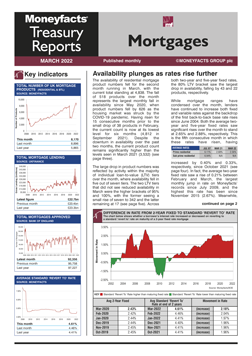Eleanor Williams, Finance Expert at Moneyfacts, said:
“The mortgage sector has demonstrated great resilience during unprecedented times, buoyed by the level of demand for the limited supply of housing stock available and the great ‘race for space’ as many people re-evaluated their property needs. The sector could continue to be fuelled by a shift in focus as remortgage borrowers, spooked by Bank of England rate rises, hurry to secure some financial stability and rush to lock into a fixed deal to protect themselves from further rate increases. This move may particularly be true for those who, by virtue of house price growth, could take advantage of increased equity in their home to potentially secure a lower rate.
“Mortgage rate re-pricing has continued at pace, with both the overall two- and five-year fixed rate averages increasing for a seventh consecutive month. At 3.03%, the two-year average has risen above 3% for the first time since March 2015 (3.06%), while the five-year equivalent of 3.17% has also risen, and sits at its highest in six years (May 2016 – 3.17%). With a margin of just 0.14% now separating these averages, the differential between the two is the smallest recorded since February 2013 (0.08%). This could indicate that providers may be adapting their pricing towards borrower preference potentially shifting towards longer term fixed rate options in order to protect themselves from further pricing volatility.
“First-time buyers could understandably be feeling disheartened by the combination of rising house prices, mortgage rates surging and increases in their cost of living impacting on affordability. They may therefore take a small glimmer of hope from the fact that, at 369 deals, the provision of products offered at 95% LTV is at its highest since pre-pandemic March 2020 (391). The average two- and five-year fixed rates at both 95% and 90% LTV may have risen month-on-month, these are the only two lending tiers where the average rates remain lower now than they were at this time last year. While there may be some who are forced to delay their homeownership dreams due to wider economic pressures, recent movements in this sector seem to indicate that lenders could be keen to continue to cater to this demographic where possible.
“Overall availability of products across the residential mortgage sector ticked up again month-on-month, with a further 162 options coming to market since April, bringing the total choice of deals up to 5,087. Those hoping to secure one of these new mortgages will note that product shelf-life remains low at 22 days, just one day longer than the record low of 21 days logged last month, so moving swiftly to get the best option available to them is wise.”
Eleanor Williams, Finance Expert at Moneyfacts, said:
“The mortgage sector has demonstrated great resilience during unprecedented times, buoyed by the level of demand for the limited supply of housing stock available and the great ‘race for space’ as many people re-evaluated their property needs. The sector could continue to be fuelled by a shift in focus as remortgage borrowers, spooked by Bank of England rate rises, hurry to secure some financial stability and rush to lock into a fixed deal to protect themselves from further rate increases. This move may particularly be true for those who, by virtue of house price growth, could take advantage of increased equity in their home to potentially secure a lower rate.
“Mortgage rate re-pricing has continued at pace, with both the overall two- and five-year fixed rate averages increasing for a seventh consecutive month. At 3.03%, the two-year average has risen above 3% for the first time since March 2015 (3.06%), while the five-year equivalent of 3.17% has also risen, and sits at its highest in six years (May 2016 – 3.17%). With a margin of just 0.14% now separating these averages, the differential between the two is the smallest recorded since February 2013 (0.08%). This could indicate that providers may be adapting their pricing towards borrower preference potentially shifting towards longer term fixed rate options in order to protect themselves from further pricing volatility.
“First-time buyers could understandably be feeling disheartened by the combination of rising house prices, mortgage rates surging and increases in their cost of living impacting on affordability. They may therefore take a small glimmer of hope from the fact that, at 369 deals, the provision of products offered at 95% LTV is at its highest since pre-pandemic March 2020 (391). The average two- and five-year fixed rates at both 95% and 90% LTV may have risen month-on-month, these are the only two lending tiers where the average rates remain lower now than they were at this time last year. While there may be some who are forced to delay their homeownership dreams due to wider economic pressures, recent movements in this sector seem to indicate that lenders could be keen to continue to cater to this demographic where possible.
“Overall availability of products across the residential mortgage sector ticked up again month-on-month, with a further 162 options coming to market since April, bringing the total choice of deals up to 5,087. Those hoping to secure one of these new mortgages will note that product shelf-life remains low at 22 days, just one day longer than the record low of 21 days logged last month, so moving swiftly to get the best option available to them is wise.”










